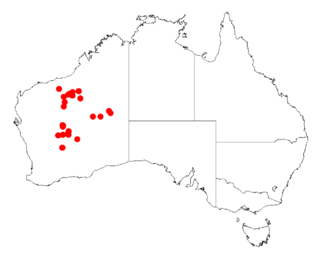
Acacia complanata, known as long-pod wattle and flat-stemmed wattle, is a perennial tree native to eastern Australia.

Acacia binervata, commonly known as two-veined hickory, is a shrub or tree that is endemic to eastern Australia.

Acacia bivenosa, commonly known as two-nerved wattle, two-veined wattle or hill umbrella bush, is a species of Acacia found in northern Australia.

Acacia cummingiana is a shrub belonging to the genus Acacia. It is native to a small area on the Swan coastal plain and the Geraldton sandplain in Western Australia.

Acacia continua, or the thorn wattle, is a shrub belonging to the genus Acacia and the subgenus Alatae. It native to New South Wales and South Australia.

Acacia gibbosa is a shrub or tree belonging to the genus Acacia and the subgenus Juliflorae native to Western Australia.

Acacia ramulosa, commonly known as horse mulga or bowgada wattle, is a shrub belonging to the genus Acacia and the subgenus Juliflorae endemic to arid areas of Australia.

Acacia symonii, also known commonly as Symon's wattle, is a tree or shrub belonging to the genus Acacia and the subgenus Juliflorae that is endemic to parts of arid central Australia.

Acacia thomsonii, commonly known as Thomson's wattle, is a shrub or tree belonging to the genus Acacia and the subgenus Juliflorae that native to parts of northern Australia.

Acacia acanthaster is a shrub belonging to the genus Acacia and the subgenus Phyllodineae. It is native to an area in the Great Southern and Goldfields-Esperance regions of Western Australia.

Acacia basedowii, commonly known as Basedow's wattle, is a shrub belonging to the genus Acacia and the subgenus Phyllodineae endemic to arid parts of central Australia.

Acacia crassiuscula is a shrub belonging to the genus Acacia and the subgenus Phyllodineae found along the south coast of Western Australia.

Acacia melleodora, commonly known as scented wax wattle,waxy wattle, honey wattle or honey scented wattle, is a shrub belonging to the genus Acacia and the subgenus Phyllodineae that is endemic to arid parts of central Australia.

Acacia nervosa, commonly known as rib wattleribbed wattle or perfumed wattle, is a shrub belonging to the genus Acacia and the subgenus Phyllodineae.

Acacia strongylophylla, commonly known as round-leaf wattle, is a shrub of the genus Acacia and the subgenus Phyllodineae endemic to central Australia.

Acacia balsamea, commonly known as balsam wattle, is a shrub of the genus Acacia and the subgenus Plurinerves.

Acacia oswaldii, commonly known as boree, umbrella wattle, umbrella bush, whyacka, middia, miljee, nella and curly yarran, is a shrub or tree of the genus Acacia and the subgenus Plurinerves.

Acacia cretacea, also known as chalky wattle, is a shrub belonging to the genus Acacia and the subgenus Phyllodineae that is endemic to South Australia.

Acacia falciformis, also commonly known as broad-leaved hickory, hickory wattle, mountain hickory, large-leaf wattle, tanning wattle and black wattle, is a shrub belonging to the genus Acacia and the subgenus Phyllodineae that is endemic to eastern Australia
Acacia polyadenia is a shrub or small tree belonging to the genus Acacia and the subgenus Juliflorae that is native to north eastern Australia.























